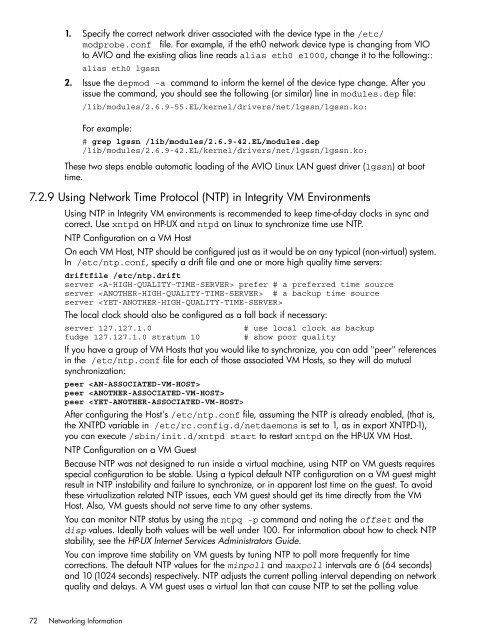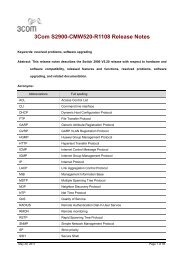HP Integrity Virtual Machines 4.2.5 - HP Business Support Center
HP Integrity Virtual Machines 4.2.5 - HP Business Support Center
HP Integrity Virtual Machines 4.2.5 - HP Business Support Center
You also want an ePaper? Increase the reach of your titles
YUMPU automatically turns print PDFs into web optimized ePapers that Google loves.
1. Specify the correct network driver associated with the device type in the /etc/<br />
modprobe.conf file. For example, if the eth0 network device type is changing from VIO<br />
to AVIO and the existing alias line reads alias eth0 e1000, change it to the following::<br />
alias eth0 lgssn<br />
2. Issue the depmod -a command to inform the kernel of the device type change. After you<br />
issue the command, you should see the following (or similar) line in modules.dep file:<br />
/lib/modules/2.6.9-55.EL/kernel/drivers/net/lgssn/lgssn.ko:<br />
For example:<br />
# grep lgssn /lib/modules/2.6.9-42.EL/modules.dep<br />
/lib/modules/2.6.9-42.EL/kernel/drivers/net/lgssn/lgssn.ko:<br />
These two steps enable automatic loading of the AVIO Linux LAN guest driver (lgssn) at boot<br />
time.<br />
7.2.9 Using Network Time Protocol (NTP) in <strong>Integrity</strong> VM Environments<br />
Using NTP in <strong>Integrity</strong> VM environments is recommended to keep time-of-day clocks in sync and<br />
correct. Use xntpd on <strong>HP</strong>-UX and ntpd on Linux to synchronize time use NTP.<br />
NTP Configuration on a VM Host<br />
On each VM Host, NTP should be configured just as it would be on any typical (non-virtual) system.<br />
In /etc/ntp.conf, specify a drift file and one or more high quality time servers:<br />
driftfile /etc/ntp.drift<br />
server prefer # a preferred time source<br />
server # a backup time source<br />
server <br />
The local clock should also be configured as a fall back if necessary:<br />
server 127.127.1.0 # use local clock as backup<br />
fudge 127.127.1.0 stratum 10 # show poor quality<br />
If you have a group of VM Hosts that you would like to synchronize, you can add "peer" references<br />
in the /etc/ntp.conf file for each of those associated VM Hosts, so they will do mutual<br />
synchronization:<br />
peer <br />
peer <br />
peer <br />
After configuring the Host's /etc/ntp.conf file, assuming the NTP is already enabled, (that is,<br />
the XNTPD variable in /etc/rc.config.d/netdaemons is set to 1, as in export XNTPD-1),<br />
you can execute /sbin/init.d/xntpd start to restart xntpd on the <strong>HP</strong>-UX VM Host.<br />
NTP Configuration on a VM Guest<br />
Because NTP was not designed to run inside a virtual machine, using NTP on VM guests requires<br />
special configuration to be stable. Using a typical default NTP configuration on a VM guest might<br />
result in NTP instability and failure to synchronize, or in apparent lost time on the guest. To avoid<br />
these virtualization related NTP issues, each VM guest should get its time directly from the VM<br />
Host. Also, VM guests should not serve time to any other systems.<br />
You can monitor NTP status by using the ntpq -p command and noting the offset and the<br />
disp values. Ideally both values will be well under 100. For information about how to check NTP<br />
stability, see the <strong>HP</strong>-UX Internet Services Administrators Guide.<br />
You can improve time stability on VM guests by tuning NTP to poll more frequently for time<br />
corrections. The default NTP values for the minpoll and maxpoll intervals are 6 (64 seconds)<br />
and 10 (1024 seconds) respectively. NTP adjusts the current polling interval depending on network<br />
quality and delays. A VM guest uses a virtual lan that can cause NTP to set the polling value<br />
72 Networking Information
















